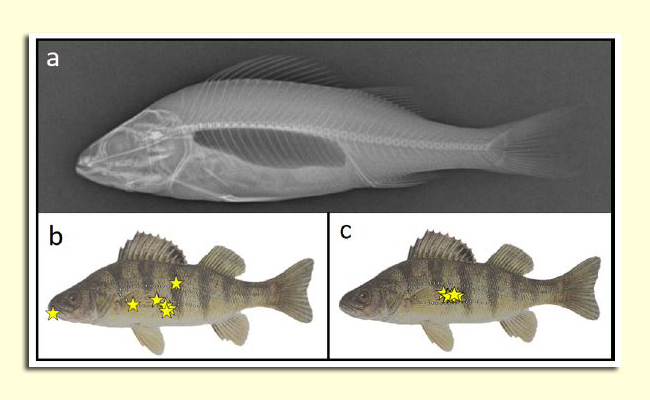NYSG initiated efforts to address and reduce the barotrauma that is damaging the valuable Lake Erie Yellow Perch fishery
Contact:
Jesse Lepak, NYSG Fisheries & Ecosystem Health Specialist, P: 315-312-3042, E: Jesse.Lepak@cornell.edu
Oswego, NY, March 4, 2019 - Lake Erie Yellow Perch support one of the largest freshwater commercial fisheries in the world. However, in the deep, eastern basin of Lake Erie, Yellow Perch often suffer tissue damage (e.g., stomach eversion, bulging eyes) when retrieved by anglers. This damage, known as barotrauma, is caused by the expanding swim bladder of the fish when retrieved from deep water. Up to 30% of these fish are released (considered too small to harvest), and, according to the New York State Department of Environmental Conservation, are unlikely to survive due to the damage caused by barotrauma.
Due to the negative impacts this phenomenon is having on valuable Yellow Perch fisheries in Lake Erie, resource managers, anglers, and stakeholders identified a need to discuss harvest and barotrauma treatment in the context of Lake Erie Yellow Perch.
New York Sea Grant (NYSG) initiated efforts to address this issue with an October 2, 2018 workshop featuring respected Lake Erie anglers and a panel of international experts on Yellow Perch barotrauma. The objectives were: (1) to exchange information and relevant experiences about barotrauma, and (2) to discuss utility and messaging in the context of barotrauma mitigation techniques.
Seven key participants (see list at right) received the most current Yellow Perch barotrauma information available. They unanimously agreed on the efficacy of four of seven ways to address barotrauma and improved their likelihood of appropriately treating fish with barotrauma using x-ray technology and information about Yellow Perch anatomy.
Post-workshop survey feedback from participants has informed the development of NYSG messaging to reduce barotrauma in Yellow Perch in 2019.

Panel a: Yellow Perch x-ray aids landmarking of swim bladder.; Panel b: prior to October workshop, location/s (stars) selected by participants where they felt a needle could be placed to relieve pressure placed on tissues by overfilled swim bladder.; Panel c: post-workshop, participants properly selected locations to relieve barotrauma pressure. Credits: X-ray: NYSG/Jesse Lepak, Midstate Veterinary Services; Yellow Perch: New York State Department of Environmental Conservation Biological Survey Series.
Partners:
• Angling community members
• New York State Department of Environmental Conservation
• Lake Champlain Sea Grant
• Midstate Veterinary Services, Cortland, NY
• Regional Science Consortium, Erie, PA
• University of Florida: Gainesville
• University of Regina, Saskatchewan
More Info: New York Sea Grant
New York Sea Grant (NYSG), a cooperative program of Cornell University
and the State University of New York (SUNY), is one of 33 university-based
programs under the National Oceanic and Atmospheric Administration’s
National Sea Grant College Program.
Since 1971, NYSG has represented a statewide network of integrated
research, education and extension services promoting coastal community
economic vitality, environmental sustainability and citizen awareness
and understanding about the State’s marine and Great Lakes resources.
Through NYSG’s efforts, the combined talents of university scientists
and extension specialists help develop and transfer science-based
information to many coastal user groups—businesses and industries,
federal, state and local government decision-makers and agency managers,
educators, the media and the interested public.
The program maintains Great Lakes offices at Cornell University, SUNY
Buffalo, SUNY Oswego and the Wayne County Cooperative Extension office
in Newark. In the State's marine waters, NYSG has offices at Stony Brook
University in Long Island, Brooklyn College and Cornell Cooperative
Extension in NYC and Kingston in the Hudson Valley.
For updates on Sea Grant activities: www.nyseagrant.org has RSS, Facebook, Twitter, and YouTube links. NYSG offers a free e-list sign up via www.nyseagrant.org/nycoastlines for its flagship publication, NY Coastlines/Currents, which is published quarterly. Our program also produces an occasional e-newsletter,"NOAA Sea Grant's Social Media Review," via its blog, www.nyseagrant.org/blog.